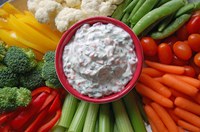Prairie Fare: Try These Safe Serving Tips for Spring and Summer Gatherings
(Click an image below to view a high-resolution image that can be downloaded)
By Julie Garden-Robinson, Food and Nutrition Specialist
NDSU Extension
I could feel the beverage attendant’s eyes on me.
I was getting a coffee refill on my way out of the restaurant.
She was placing another coffee canister in place. She continued glaring at the side of my head without a word.
I thought my hair was going to start on fire.
Then I realized what I was doing wrong. I was supposed to get a new paper cup.
“Oh, I’m sorry!” I said to the attendant as I almost ran out the door. “I promise to get a new cup next time.”
I was wondering if I was going to be banned from the restaurant, or cuffed and brought to a holding unit.
I was wearing a mask, anyway.
I thought about the situation as I got in our car with my husband.
“What would you say is the point of contamination in the beverage area?” I asked.
“The handle on the canister is the main issue,” he replied matter-of-factly.
“Absolutely,” I noted. “I touched the handle with my hands but no one cleaned the handle.”
“You had an ‘air gap,’ too, and that’s a good thing,” he replied.
In other words, my cup was several inches from the spigot. I wasn’t dipping the spigot into my coffee cup.
I wasn’t putting my mouth under the spigot to do a coffee taste test, either.
My husband and I have odd conversations. We each have many years of food-related professional experience.
They probably should have moved the self-service station behind the counter. At least 25 people had touched the handle during the time we were in the restaurant.
I grabbed the bottle of hand sanitizer in our car and put a generous dollop on my hands.
I thought about serving at our daughter’s upcoming graduation party at our home. How can we follow safety protocols in our home environment?
Cross-contamination is a major food safety issue to avoid, along with hot- and cold-holding of perishable foods.
Different states have differing recommendations for gatherings and have other safety precautions in place, so be aware of these. Most COVID-19 transmission is through the air. Keeping our distance from each other remains an important part of the equation for reducing risk.
In fact, “the risk of getting sick from COVID-19 from eating or handling food and food packages is very low,” according to the Centers for Disease Control and Prevention.
However, bacteria, such as salmonella and E. coli, can be spread through equipment, food and water. Be sure to follow safety handling guidance this spring and summer:
- Wash your hands thoroughly and frequently. Enough said.
- Wash and sanitize work surfaces and equipment. Sanitizing and disinfecting are two different things. Sanitizing uses a lower concentration of the active chemical, such as bleach. Be cautious about the use of disinfectants on surfaces. Read and follow the directions and safety precautions on the container.
- Enjoy outdoor events such as a picnic in a park with ample space to spread out.
- Consider single-serving items, such as offering individual bags of chips instead of a communal bowl of chips. Be creative with premade fruit kabobs or salads on a stick. Prepare skewers of meat and veggies ready for the grill.
- Enlist the help of a dedicated server. The server should use tongs, spoons or another barrier between the food and the server’s hands. Or have the server wear clean plastic gloves and change them any time cross-contamination occurs.
- Be aware of food allergies. Label the foods with the name and any potential allergens. You might want to avoid serving nut-containing items, for example.
- Keep hot foods hot and cold foods cold. Place cold food in containers on ice. Hold cold foods at or below 40 F. Food that will be portioned and served on the serving line should be placed in a shallow container nested in a deeper pan filled partially with ice. Place hot food in chafing dishes, preheated steam tables, warming trays and/or slow cookers.
- For more food safety information, see the NDSU Extension publication “Cooking for Groups” (available at https://tinyurl.com/3zxpc78a).
Promote healthful choices at your events, too. Have colorful fruits and vegetables available for your guests. Serve some whole-grain items, such as whole-grain buns or crackers. Select lean proteins and use lower-fat dairy options to reduce calories.
Here’s a dip that combines dairy with various chopped vegetables. Spinach and kale earn an “A-plus” from me, anyway, for their vitamin and mineral content. Serve this dip with a variety of colorful vegetables such as carrots, broccoli and/or cauliflower florets, bell pepper strips and grape tomatoes.
Spinach and Kale Dip
16 oz. fat-free plain Greek yogurt
3 Tbsp. light mayonnaise
3 cloves garlic, minced
1/2 tsp. onion powder
1/2 tsp. garlic powder
1/2 tsp. dill
1 c. kale, finely chopped
1 c. spinach, finely chopped
1/3 c. bell pepper, minced
1/3 c. carrot, minced
Salt and pepper to taste
Mix yogurt, mayonnaise and seasonings. Add chopped vegetables and stir to combine. Chill for at least two hours. Serve in a bowl nested in a larger bowl of ice.
Makes 14 (1/4 cup) servings. Each serving has 35 calories, 1 g fat, 4 g protein, 3 g carbohydrate, 0 g fiber and 40 milligrams sodium.
(Julie Garden-Robinson, Ph.D., R.D., L.R.D., is a North Dakota State University Extension food and nutrition specialist and professor in the Department of Health, Nutrition and Exercise Sciences. Follow her on Twitter @jgardenrobinson)
NDSU Agriculture Communication - May 13, 2021
Source: Julie Garden-Robinson, 701-231-7187, julie.garden-robinson@ndsu.edu
Editor: Ellen Crawford, 701-231-5391, ellen.crawford@ndsu.edu




